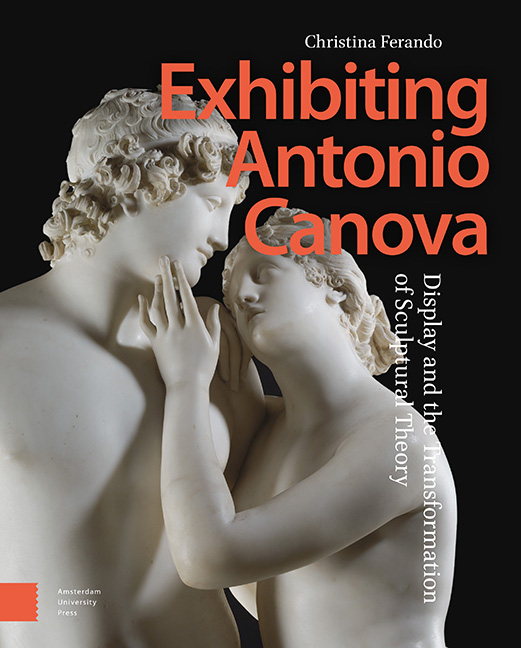Book contents
- Frontmatter
- Table of Contents
- List of Illustrations
- Acknowledgements
- Introduction: Canova on Display
- 1 Imagining Sculptural Practice
- 2 Reevaluating Ancients and Moderns
- 3 Anatomizing the Female Nude
- 4 Challenging the Supremacy of Painting
- 5 Defining Modern Sculpture
- Conclusion: Aftereffects
- Bibliography
- Index
2 - Reevaluating Ancients and Moderns
Published online by Cambridge University Press: 13 February 2024
- Frontmatter
- Table of Contents
- List of Illustrations
- Acknowledgements
- Introduction: Canova on Display
- 1 Imagining Sculptural Practice
- 2 Reevaluating Ancients and Moderns
- 3 Anatomizing the Female Nude
- 4 Challenging the Supremacy of Painting
- 5 Defining Modern Sculpture
- Conclusion: Aftereffects
- Bibliography
- Index
Summary
Abstract: Chapter two, “Reevaluating Ancients and Moderns,” focuses on Canova’s attempt to cement his legacy through the display of his Triumphant Perseus in relation to the Apollo Belvedere. The comparison was meant to highlight Canova’s innovative “imitation” of antiquity. However, the changing political circumstances from 1801 to 1815, the different locations in which this comparison took place, and the fact that the Apollo was present only as a plaster reproduction for much of the period not only resulted in shifting opinions about Perseus but also contributed to a change in attitude towards imitation in artistic practice. Once considered a fundamental and generative part of the creative process, imitation took on increasingly negative connotations as mere copying.
Keywords: imitation, originality, Triumphant Perseus, sculptors’ studios, Vatican Museums, Louvre Museum
If the relationship of Canova’s Venus and Adonis in Naples inspired authors to reflect on sculptural production, the completion and display of Triumphant Perseus (1787–1801) in Rome enabled viewers to rethink the relationship between ancient and modern sculpture. When exhibited in both his studio and the Museo Pio-Clementino, Canova’s Triumphant Perseus was juxtaposed with one of the Vatican’s treasures, the Apollo Belvedere. The comparison allowed viewers to think more deeply about artistic training, particularly how artists selected their subject matter, determined the figure’s composition, and positioned their works in relation to those of their predecessors. At the same time, these juxtapositions, and the focus they brought to the antique objects and their legacy, also established the modern definition of “imitation” as a negative term.
Imitation as Creative Practice
Sculptural practice, as we learned from Venus and Adonis, was often misunderstood by both critics and viewers who were ignorant of the complexities of the craft. Yet, if the technical and physical aspects of execution were confounding, so too was the process of invention itself. The conceptual process that lay behind artistic creation was often framed in terms of genius, with its concomitant emphasis on inspiration and spontaneity. What this emphasis on brilliance discounted, however, was the elaborate process of artistic training that was the true foundation for invention.
- Type
- Chapter
- Information
- Exhibiting Antonio CanovaDisplay and the Transformation of Sculptural Theory, pp. 83 - 122Publisher: Amsterdam University PressPrint publication year: 2023



